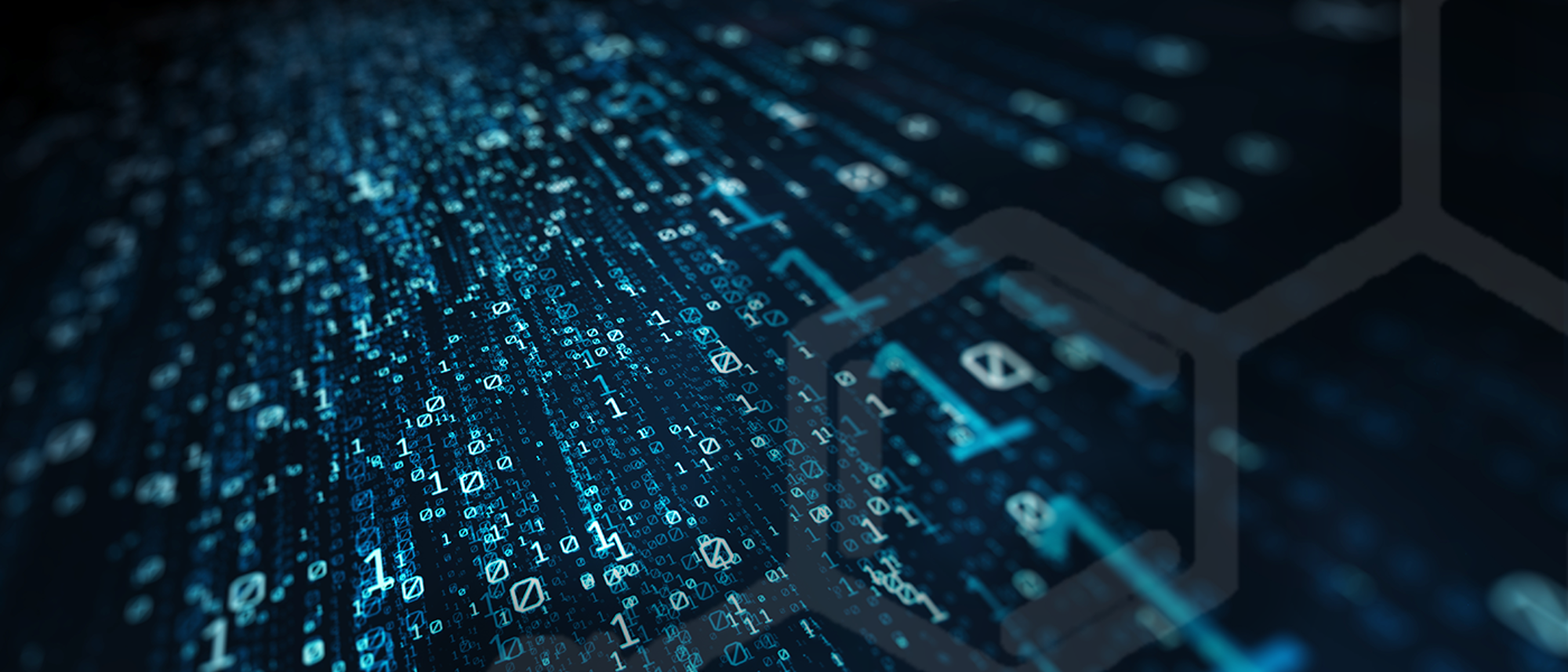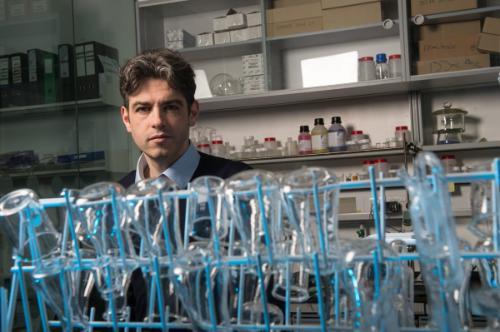
Digitising chemistry
A new era for drugs: discovery, distribution and production using robotics, computing and a universal code for chemistry.
In Professor Lee Cronin's lab, scientists are trying to recreate the processes that may have brought about the beginning of life. They also want every individual on the planet to be able to have personalised drugs produced for them on demand.
These two seemingly separate pathways towards ambitious scientific goals both demand innovations that are driving the digitisation of chemistry, the emergence of the robot chemist and, eventually, the chemical internet.
Two papers released by the group in early 2018 act as early milestones on the way to a future where these ambitions are realised. One details the digitisation of the process to manufacture the drug Baclofen, a big step towards the robotic chemist making molecules on demand. The other reports on the Cronin Group's development of robotic formulation spaces that use machine learning and artificial intelligence to drive evolutionary process within novel chemical systems.
While they appear to address different purposes, they both reflect an ambition within the group to drive chemistry into a new era, and explore complex chemical systems. One where robotics and artificial intelligence enable new molecular discoveries in a way that can be captured and codified digitally, and then downloaded and reproduced by a universally compatible system of hardware and code.

Professor Lee Cronin
The digitisation of drugs
Potentially, the future of health care could be transformed if drugs were available on demand and tailored to the individual. With the current model, a limited number of drug factories produce a limited number of drugs. These factories are often configured to produce an on-patent drug. Once the patent runs out, the factory will be reconfigured to produce another on-patent drug. For this reason, only a small percentage of the pharmaceuticals that have ever been discovered are available at any time.
This leaves drug production vulnerable to the economies of scale. It means population groups in deprived areas may not get access to medicine cheaply if the drugs they need aren't required elsewhere.
Also, as we better apply our understanding of the human genome and move toward more personalised forms of medicine, the current drug development and production cycle is incompatible with the promise of individualised drugs. Digitising chemistry has the potential to allow small batches of highly personalised medicines to be produced at a regulated vendor – perhaps a future version of your local pharmacy.
If we move off earth, and even send astronauts to Mars, it won't be possible to take all the pharmaceuticals that could possibly be needed. The potential here is for a robot that can take the digital code for any drug ever created, combined with a universal set of base chemicals, and make any drug required, for any individual on board using equipment that doesn't create a huge burden on the payload.
This concept also applies to scenarios where specific drugs are needed urgently in very remote places on earth.

Digitising the production of drugs has the potential to improve access to medicines in very remote places
A 'Spotify' for chemistry?
Currently, drug manufacture exists at the small scale and the large. At one end of this spectrum you have the organic chemist synthesising a molecule in a lab. At the other is a factory producing a large quantity of a (usually) on-patent drug.
The processes of the lab present issues around replicability, while the systems driving large-scale manufacture of pharmaceuticals create issues around availability and accessibility.
For Professor Cronin, the digitisation of chemistry provides a collective solution to both of these issues. He wants to ‘chemify’ practical chemistry.
For drug discovery within the lab, precision robotics and artificial intelligence can enable and optimise the discovery of new molecules. More importantly, it will do this in a way that can capture the process for making it in a universally-replicable code.
Then because this code is available in a universal digital format, it provides the instructions for a robot chemist with compatible hardware to produce the drug on demand. It is this step which addresses the difficulties around drug availability, opens up the possibilities of personalised drugs and provides an alternative to the large-scale manufacture of in-demand pharmaceuticals.
With access to a simple set of base chemicals and the ability do the reactions as dictated by the code, in effect this robot becomes the drug factory, one that is flexible, responsive and even personal.
"The ultimate aim is a system where we produce the molecule according to a code that we can give to one another,” explains Professor Cronin. “We could do this with programmable robots, or even 3D print the chemical-plant. Then not only to have that code for the chemical plant but we also use it to add in the chemicals. Even more interestingly, you could also have a cell culture at the bottom of the vessel. Using this, you could then start to screen your particular mixture of chemicals to find the ones that will be correct for you - maybe if you had an infection and you wanted to choose the right antibiotic."
This idea of the chemical internet Cronin describes as a 'Spotify' for chemistry. A model for collaborating with chemical code where the chemist develops a molecule (a drug for instance) and makes it available for others to download and use. In this way, the chemist could receive royalties for these downloads. The easiest to reproduce will be the most popular and hence receive the most downloads.
This in itself creates another advantage. Incredibly complex molecules often need highly skilled chemists to produce them. If in the process of discovering an important and useful molecule, the steps they took to create it were recorded and digitised in a way that made this new molecule reproducible, then the profile of the role undertaken by the best chemists would shift to having a greater emphasis on drug discovery rather than manufacture.
"What we are asking," says Professor Cronin, "is how can we change our hardware in the lab so that we can capture and exchange code for making molecules? And when you have discovered a new molecule, then because you have that code and it’s a specific piece of code that works every time, why not just use that to manufacture it in smaller amounts more reliably?
"This is about the cost of pharmaceuticals and it is about the logistics of distributing pharmaceuticals. It means we are thinking about what we need as customers of chemistry rather than what is available, because we only have a limited number of factories making the chemicals we need every day."
A key step
In a paper published in the journal Science in January 2018, the group's researchers described how they successfully produced Baclofen, a muscle relaxant, using some of the key concepts behind this digitisation of chemistry.
They analysed and documented the process for making the drug in the lab. Through experimentation with the process they were able to create a reproducible code for a 3D-printable reactionware kit made from polyethylene. This code is used by a 3D printer to produce a portable factory, which was then used to make the drug by adding the chemicals in a pre-defined fail-safe sequence.
“This approach is a key step in the digitisation of chemistry and will allow the on-demand production of chemicals and drugs that are in short supply, hard to make at big facilities, and allow customisation to tailor them to the application," says Professor Cronin.
The Chemputer
Another paper was published in Science in November 2018, where the group presented for the first time how synthesis of important drug molecules can be achieved in an affordable and modular chemical-robot system they call a chemputer.
They demonstrated the potential of the system by producing three different pharmaceuticals in one robot system, simply by changing the software and input chemicals. They created the sleeping drug Nytol, seizure medication Rufinamide, and erectile dysfunction treatment Viagra in yields comparable to those achieved in traditional human-controlled synthesis.
The desktop-sized chemputer itself draws raw chemical materials in liquid form into and out of a series of modules capable of performing the operations necessary to complete a synthetic sequence.
Machine learning
Another strand of this digitisation of chemistry is the introduction of machine learning and artificial intelligence (AI) for the discovery of novelty within chemical systems and the optimisation of these characteristics.
One of the key objectives in the Cronin Group is understanding or recreating the potential origins of life, or how to recreate the complexity within chemical systems that may have set off the processes from which the most basic building blocks of life appeared.
Their machine learning and robotics technologies allow them to create, in effect, evolutionary and natural selection processes within chemical systems. It allows them to create and trial an infinite number of chemical systems, use AI to select for properties that display complexity and use the techniques of robotics to continually select and evolve this complexity to see what occurs.
In a paper published in PNAS, the group reported on the use of these technologies to build unstable oil-in-water droplets as models for new artificial life forms. This robot equipped with machine learning was also able to predict their properties ahead of time even though conventional physical methods failed to do so.
The team's robot deposits the oil-in-water droplets
This kind of research is prohibitive with traditional lab-based approaches to chemistry because the behaviours exhibited and observed spring from what would appear to be randomness in the combination of oil and water droplets. This means that when you do generate interesting behaviours using combinations of chemicals, it can incredibly difficult to recreate them because of this randomness.
Using robots equipped with machine learning gives them the precision to recreate the placement and volume of chemicals exactly as specified and to capture the process they followed digitally – therefore, in a way that is replicable.
Enabling precision and replicability within these areas of chemistry creates the potential for a whole new era of molecular discovery. This enables the pathway of drug discovery and replication that has the potential to drive the chemical internet.
"Our experiments with oil droplets demonstrate them exhibiting strange behaviours but these droplets only have four chemicals in them, only four, and by varying those four you get ones that explode, move, they wobble. So you get really interesting discoveries that occur in this formulation space." explains Professor Cronin. "We could not only use a digitisation of kind of hard sounding chemical reactions, but we can physically make objects. These could be used to release molecules, release drugs, or may be used for formulation for cosmetics. This happens by combining the chemistry and the robotics together."
Selected publications
- 'Organic synthesis in a modular robotic system driven by a chemical programming language, Science
- 'Digitization of multistep organic synthesis in reactionware for on-demand pharmaceuticals', Science
- 'Artificial intelligence exploration of unstable protocells leads to predictable properties and discovery of collective behavior' Proceedings of the National Academy of Sciences (PNAS)
- 'Networking Chemical Robots Using Twitter for #RealTimeChem,' ChemRxiv
- Controlling an organic synthesis robot with machine learning to search for new reactivity. Nature
Interviews
How far away is the chemical internet?
This is a long-term vision. Professor Cronin finds parallels with the way the processing power of computing itself developed over time. Presenting at the Hello Tomorrow Global Summit, he said:
"The valve transistor worked many, many years ago, and then it was conceptually possible to design a processor as complex as the processor you have in your phone and your computer. But it took many years for the technology to fully realise this concept.
"So we ask, what is the minimal unit of chemistry that we can daisy chain together to modularise it so that we can do chemistry over many, many steps and make really large molecules? In the same way that we can make very, very sophisticated processers that can do many calculations per second.
"So this is what we're trying to do at the moment, to find this minimal unit of chemistry and make it modular and universal. We have actually made a cheap robot chemist that collaborates with other robot chemists in different places and communicates using a web page or even using twitter."
While it's tempting to see this as leading to the promise of downloadable and printable drugs in your kitchen someday soon, Professor Cronin is wary of this interpretation even if it becomes possible, owing to clear issues around regulation and risk. He has his own sense of how the technology might evolve in practice. In an interview with Disruptive Magazine, he outlined the stages this process may follow:
"I think the intermediate step in my lifetime, in my lab, is we will be discovering new molecules using these systems,” he says. “This will break into new ground for drug discovery, customisation of new chemical products, and the exploration and use of more complex molecules than is possible today.
“We'll then break the new ground for manufacturing. Drug companies will have their own secure facility for the code, for the robots, and they'll make the molecules much more cheaply and quickly than before.
“But then once that's happened, there is the potential to add on as we personalise. So I think the driver won't be, 'can we make drugs at home?', but can we make them personal, that are tailored to your genome and to your environmental needs."
Funding
This research is funded by the University of Glasgow complex chemistry initiative along with the European Research Council and the Engineering & Physical Sciences Research Council (EPSRC).
Professor Cronin has a long-standing relationship with EPSRC; support provided by EPSRC over the last 16 years has aided in the development of diverse research areas, ranging from the development of inorganic fuels for water splitting to the use of configurable robotics for the programming of drug discovery and novel materials.
He is currently the principal investigator for projects in receipt of EPSRC grants worth £7.6 million and is co-investigator on a further four grants totalling £9.9 million, while EPSRC has supported 20 previous research projects since 2002.
Additionally, the business activity of DeepMatter Group PLC, the AIM-listed company of which Professor Cronin is the founding scientific director, is the digitisation of chemical space.
Funders:
Discover more:
- Professor Lee Cronin
- Cronin Group: Complex Chemical Systems

